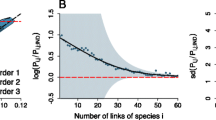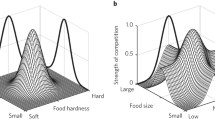Summary
There is a long-standing dispute over whether the analysis of species co-occurrence data, typically on islands in an archipelago, can disclose the forces at work in structuring a community. Here we present and utilise three “scores” S, C and T. S gives the mean number of islands shared by a species pair in the presence/absence data under study. The scores C and T are based on the way that a pair of species occurs on a pair of islands. When each species occurs on a different island, this adds to the “checkerboard score” C; if they occupy the same island, this increases the “togetherness score” T.
In judging whether observed values of S, C and T are compatible with a null hypothesis assuming no species interaction, we follow Connor and Simberloff (1979) in generating a “control group” of (constrained) simulated incidence patterns.
Presence/absence matrices can have paradoxical features, in combining a high mutual exclusion by species (checkerboardedness) with a degree of species aggregation that is also high. We show that this is in fact inevitable — that, given the usual contraints, C and T can differ only by a constant. This means that extreme checkerboardedness can be produced by forces making for species aggregation, just as well as by those making for avoidance.
If we restrict our attention to a subset of species, the constraints are less rigid and the S, C and T scores are somewhat freer to vary. We consider the confamilial subsets in the Vanuatu archipelago as likely candidates for revealing any competition forces at work. Calculating the actual S, C and T scores for these subsets, we compare them with the corresponding scores in a sample of simulated colonization patterns.
The actual species-distributions differ significantly from what we would expect if the colonization choices of different species were uncorrelated (save for some biological constraints). The confamilial species of the real world share more islands, and occur in a pattern less checkerboarded, and more aggregated, than their simulation counterparts. This suggests that competition pressures, if they exist, are overcome by countervailing factors.
The method used is applicable in other ways, and to a wider class of problems, in analysing the forces behind community structure.
Similar content being viewed by others
References
Connor EF, Simberloff D (1979) The assembly of species communities: chance or competition? Ecology 60:1132–1140
Connor EF, Simberloff D (1983) Interspecific competition and species co-occurrence patterns on islands: null models and the evaluation of evidence. Oikos 41:455–466
Connor EF, Simberloff D (1984) Neutral models of species' co-occurrence patterns. In: Strong DR, Simberloff DS, Abele LG, Thistle AB (eds) Ecological communities: Conceptual issues and the evidence. Princeton University Press, Princeton, pp 316–331
Den Boer PJ (1980) Exclusion or coexistence and the taxonomic or ecological relationship between species. Netherl J Zool 30:278–306
Diamond JM (1975) Assembly of species communities. In: Cody ML, Diamond JM (eds). Ecology and evolution of communities. Cambridge Mass: Harvard University Press, pp 342–444
Diamond JM, Gilpin ME (1982) Examination of the “null” model of Connor and Simberloff for species co-occurrences on islands. Oecologia 52:64–74
Diamond JM, Marshall AG (1976) Origin of the New Hebridean avifauna. Emu 76:187–200
Diamond JM, Marshall AG (1977) Distributional ecology of New Hebridean birds: A species kaleidoscope. J Anim Ecol 46:703–727
Gilpin ME, Diamond JM (1982) Factors contributing to non-randomness in species co-occurrences on islands. Oecologia 52:75–84
Graves GR, Gotelli NJ (1983) Neotropical land-bridge avifaunas: new approaches to null hypotheses in biogeography. Oikos 41:322–333
Roberts A, Stone L (1990) Island-sharing by archipelago species. Oecologia 83:560–567
Schoener TW, Adler GH (1991) Greater resolution of distributional complementarities by controlling for habitat affinities: A study with Bahamian lizards and birds. Am Nat 137:669–692
Stone L, Roberts A (1990) The checkerboard score and species distributions. Oecologia 85:74–79
Williams CB (1951) Intra-generic competition as illustrated by Moreau's records of east African bird communities. Jnl Anim Ecol 20:246–253
Wilson JB (1987) Methods for detecting non-randomness in species co-occurrences: a contribution. Oecologia 73:579–582
Wright SJ, Biehl CC (1982) Island biogeographic distributions: testing for random, regular and aggregated patterns of species occurrence. Am Nat 119:345–357
Author information
Authors and Affiliations
Rights and permissions
About this article
Cite this article
Stone, L., Roberts, A. Competitive exclusion, or species aggregation?. Oecologia 91, 419–424 (1992). https://doi.org/10.1007/BF00317632
Received:
Accepted:
Issue Date:
DOI: https://doi.org/10.1007/BF00317632




